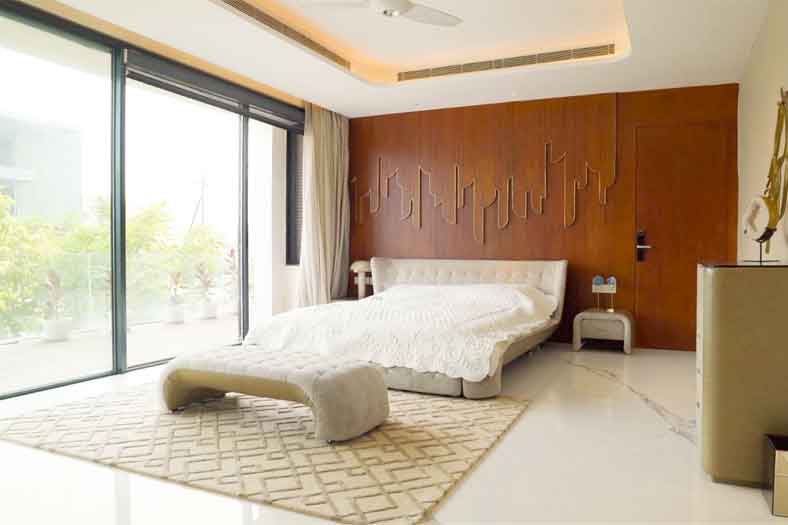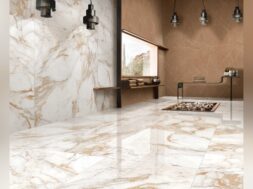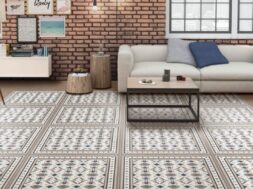Evolution and changing dynamics of tiles

Tiles might not be at the centre of designing but plays a crucial role in adding aesthetic appeal to the design. From evolution to selection to customisation, let’s check out various factors.
Indian architecture and interior design has evolved over the years and it still continues to surprise and amaze us. When we talk about designing and adding value to the place, tiles have always played an integral role in designing of a particular place and it can really light up a place without being the star attraction. Tiles have generally been used in flooring, kitchen, bathroom but the usage of tiles is expanding and making foray into commercial places, walls, business places, offices and other places. The types tiles has also undergone a massive change with more and more different types getting used apart from ceramic and porcelain tiles.
Evolution of tiles: The sizes of tiles have also become more customised and gone are the days using only 12 cm x 12 and large slabs and now we have access to 120 x120, 60 x 120, 30 x 120 and so forth.
Love Choudhary, Founding Partner and CEO, AND Studio states that tiles have evolved over a period of time but basics of it still remain the same. He says, “The range of finish material options for building is nearly limitless but tiles still hold up as a great choice in many situations. The reasons haven’t really changed. It is durable and relatively low cost. We believe in adhering to the client’s needs and wishes in the best budget possible, which is mostly made possible by suggesting tile solutions instead of over the top expensive stones. Also, the tiles come pre finished, retaining their look and finish for years, whereas with stone, it required timely polishing and high maintenance.”
He further adds, “Tiles can be easily cleaned and stands up to a lot of wear – with a relatively long expected life span for a building material. And while tile can be sourced from anywhere in the world, you can also make a sustainable choice by finding locally manufactured tile in any part of the country. There is no aesthetic trade off for all these economic and environmental benefits – the variety of colour and a texture combination available in tile is huge.”
Rohit Suraj, Founder, Urban Zen perfectly sums up the evolution of tiles and says, “It’s the sheer choice that makes tiles an attractive option. From porcelain to ceramic, glass to metal or even cement to mosaic tiles. Tiles by itself is no longer a medium for only the ones on a budget. On the contrary many tile manufacturers have moved into ‘exotics’ be it in large formats or textured and decorated surfaces. Mosaics itself through varying mediums have become in many cases ‘aspirational’ for most. Companies like SICIS Gigacer, Mutina and Mirage amongst others have really taken tile and mosaic making to a level that’s ‘artisanal’ inmany ways. Tiles as a medium are no longer a ‘compromise’ but instead an ‘option’ and at the upper end of the spectrum even ‘aspirational.’”
Amit Shah, Managing Director, CMC gave his opinion on the evolution of tiles and said, “The rapid improvements in technology help deliver superior quality products from time to time. Plus varied choices in material, sizes, designs and colours offer authority to customers to choose the best suitable product without making compromises.”
Selection of tiles for residential vs commercial spaces: Selection of tiles for commercial and residential spaces vary owing to the utility. Commercial spaces unlike residential spaces are high trafiic areas.
Dinesh Vyas, Sr. Vice President – Markeitng, H & R Johnson (India) offers his take and says, “The key difference in criteria to choose tiles for different application areas comes up due to different usage environments. While there may not be much difference needed for wall application tiles, what really matters is – flooring. When we say commercial space, it includes tiled surfaces of exterior portion as well.”
He further adds, “Residential space has lesser people, at least on a regular basis and lesser movement of material over tiled surface. The situation is just reversed in commercial space. It means that not only the mechanical strength of tile (breaking strength) but also the quality and characteristics of the top surface of the tile is very important. It must be resistant enough to the day to day scratch causing substances that come along with our shoes and other objects moving on the floor. Similarly, the level of reflectance could become an important criterion as it will influence the overall ambiance in the finished space. The two top concerns that may suggest avoiding using a particular tile in commercial space are – mechanical strength and scratch resistance.”
Ar. Abhigyan Neogi, Founder & Principal Architect at Chromed Design Studio offers his opinion on tiles used for residential spaces and says, “As far as residential spaces are concerned, tiles have increased in demand mainly because of their resilience and adaptability. They can be installed in a variety of environments with no worry of constraints such as water, stains and allergic odours. Tiles are a very popular option among homeowners as they offer a great value for one’s budget with huge benefits. Tiles are an economically viable option and come in a variety of colours, textures and patterns. At the same time they can be mixed and matched among the different colours or tiles randomly for a unique look. For instance, mosaic tiles can be used to alleviate the look of the expanse or create a focal point.”
Cookie Consent
We use cookies to personalize your experience. By continuing to visit this website you agree to our Terms & Conditions, Privacy Policy and Cookie Policy.









